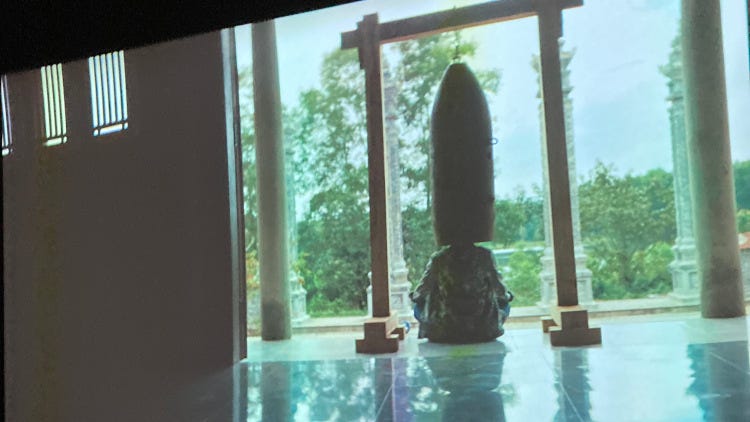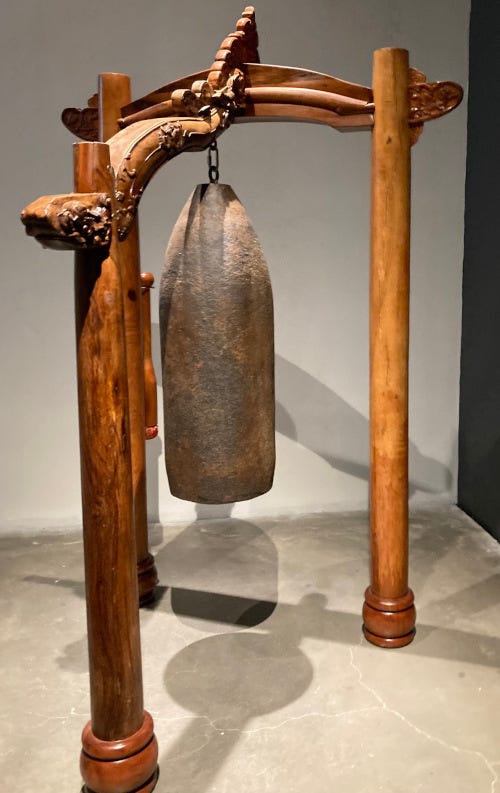Let no one enter who is not a boomer.
Review: Tuan Andrew Nguyen: Radiant Remembrance at the New Museum
Tuan Andrew Nguyen: Radiant Remembrance. The New Museum, NYC, June 29 through September 17, 2023. https://www.newmuseum.org/exhibitions/view/tuan-andrew-nguyen-radiant-remembrance
Admissions Rating: Amiable, yes. Proactive, no.
This is all wrong. First of all, you’d have to spend hours at this show, say a couple of hours like in one of those movie theaters they used to have, where you sit in one place and watch stuff happen. Second, there’s feelings involved. Lots.
And third: the feelings are mostly about stuff that older folks mostly have feelings about: a father who’s lost contact with his son, a daughter who will never see her father, a cousin in need of forgiveness.
And the Vietnam War—actually the American War: Tuan Andrew Nguyen is Vietnamese-American Vietnamese, meaning he came to America, got his art chops here, then returned to Vietnam and he makes movies—highly sophisticated productions, don’t be fooled—about loss: loss of family and loss of a place in the world, the two so tightly knit it’s no longer possible to tell them apart.
The Unburied Sounds of a Troubled Horizon (2022) is by far the most rooted: rooted in the landscape and experiences of a country ravaged by unexploded ordnance and unresolved family feuds. It’s also the one piece in the show that makes the most demands on an American audience, demands of memory and knowledge. You’d have to know the meaning of the mudra, the hand gesture of a statue of Quan Yin the Bodhisattva of Compassion: the artist reproduces these hands in metal from unexploded ordnance, to fit the missing hands of Cousin Lai, because of whom… It might help as well to know the artist Alexander Calder was a figure in the American anti-war movement, because the heroine, Nguyet, believes she’s channeling Calder. As a Buddhist monk explains (the same who sits beside a temple gong made from a shell casing), there are sounds of such a pitch that only dogs can hear them. Or old folks. I’m not sure the hipsters know the difference.
This one’s the most linear of the three videos on show: it has a story line of sorts, and signifying props embedded in the story, “objective correlatives,” we
used to call them. No linears and no props in The Specter of Ancestors Becoming [2019], which narrates several stories at once on several screens simultaneously, stories from and from the children of the Black African soldiers who deserted to the Viet-Minh during the first Vietnamese War (actually the French War, I guess), and who address the alienation of the uprooted. The setup (not the stories) might make the young folks happy, it’s kinda like a club, except the telling’s held together by the narrative voices and subtitles, which don’t overlap:
But the clearest, most lyrical of the three videos is the most recent, appropriately titled Because No One Living Will Listen [2023]: it’s “about” a Vietnamese woman trying to move beyond the memories of her Moroccan father:
Actually it’s not “about” in the art-world sense. The video (a computer-generated something-or-other) doesn’t “reference” shit. Rather, like all the others, it works upon images and correlatives, skillfully manipulated. As I’ve noted elsewhere, this movement in art (let’s call it the New Affect, a kind of Neue Sachlichkeit in reverse) seems to be developing simultaneously today in formerly marginalized countries, aesthetically. No less political than the old art, but soaked with pleasure, “revolutionist from the direct sense of personal worth, that pride of life, which to the Greeks was a heavenly grace.”
Yeah, yeah, I know. Slaveholding dead White men. Now make like an endangered bio-organism, and leave.
São Paulo, September 13, 2023
WOID XXIII-27





